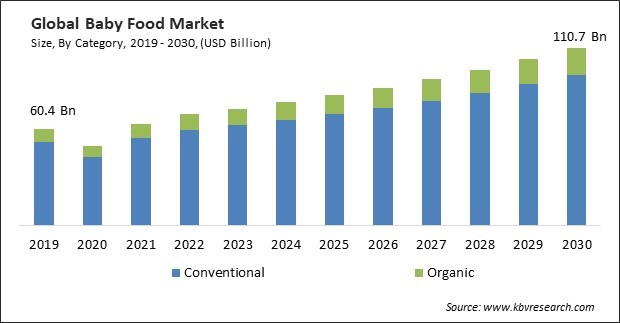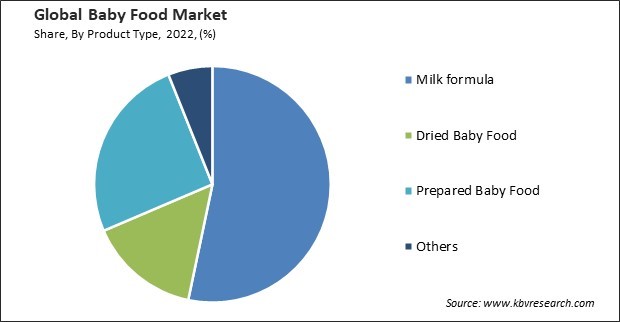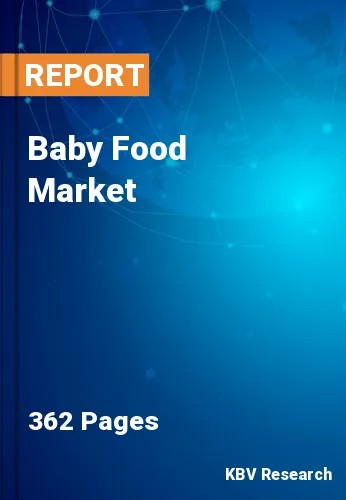The Global Baby Food Market size is expected to reach $110.7 billion by 2030, rising at a market growth of 6.2% CAGR during the forecast period. In the year 2022, the market attained a volume of 2,339.0 Kilo Tonnes, experiencing a growth of 6.2% (2019-2022).
There are more organized stores and supermarkets, the growth of which is being helped by using more modern marketing methods and getting these goods into more places to buy them, like grocery stores, shopping malls, and hypermarkets. Therefore, the supermarkets/hypermarkets segment captured $ 29,676.0 million revenue in the market in 2022. With more stores and supermarkets, manufacturers can expand their product offerings. This diversity allows parents to find a wide range of baby food products catering to different tastes, dietary preferences, and developmental stages. Some of the factors impacting the market are improving awareness of adequate nutrition, growing number of working women, and increasing consumption of homemade food for babies.

Mothers' eating habits have the most impact on their babies' health. As more women in emerging and developed countries learn to read and write, more people are aware of what newborn babies need to stay healthy. In some wealthy countries, babies aged 6 to 7 months were seen to be weaning later than expected. However, these prolonged weaning cases should decrease as parents become more aware of the problem. Additionally, as the number of people working increases around the world, it may become more challenging to make sure that kids get the right amount of nutrition. Because of this, there is a huge demand for baby food, and people who work are thought to buy the most baby food. Also, working women are more likely to switch to baby food now that they know more about its benefits, such as having a lot of fruits and veggies, low sodium and fat, being easy to make, and so on. Hence, there is a direct relationship between the growing numbers of women in the workforce and the ever-increasing sales of baby food.
However, there are many interconnected factors that can affect complementary eating practices and following health advice. Some of these are socio-economic and cultural factors. Most experts say babies should start eating solid foods around six months of age. Because of this, parents are choosing to make their food because it is the healthiest and most natural way to give their kids fresh, tasty, and nutritious foods. People in rural areas eat at more home-cooked meals because they don't know where baby food is available or its benefits. Therefore, the rising preference for feeding babies home-cooked meals will obstruct the development of the market.
By category, the baby food market is bifurcated into conventional and organic. The conventional segment registered the maximum revenue share in the baby food market in 2022. Conventional baby food is widely available in most grocery stores and supermarkets, offering convenience to parents who might not have easy access to specialized products. Some parents trust well-known conventional baby food brands and feel more comfortable with products established in the market for a long time. Moreover, conventional baby food is often affordable, making it more accessible to families on a budget.
Based on product type, the baby food market is divided into dried baby food, milk formula, prepared baby food, and others. Prepared baby food acquired a substantial revenue share in the baby food market in 2022. New flavors and the need for healthy, ready-to-eat baby foods are responsible for the segment's growth. People like zip-lock bags and handy packages because they are simple to carry, store, and use. They show the ingredients and the number of nutrients in the food. Also, prepared foods make it easy to prepare food while traveling, which is only sometimes possible when cooking from scratch.

On the basis of distribution channels, the baby food market is segmented into supermarkets/hypermarkets, drugstores/pharmacies, online channels, convenience stores, and others. The supermarkets/hypermarkets segment gained the maximum revenue share in the baby food market in 2022. Lifestyle improvements brought about by more disposable income and the influence of Western society are the main things that are driving the growth of this segment. More and more people are shopping at supermarkets because they have a lot of different goods in one place, enough parking, and accessible hours.
| Report Attribute | Details |
|---|---|
| Market size value in 2022 | USD 69.3 Billion |
| Market size forecast in 2030 | USD 110.7 Billion |
| Base Year | 2022 |
| Historical Period | 2019 to 2021 |
| Forecast Period | 2023 to 2030 |
| Revenue Growth Rate | CAGR of 6.2% from 2023 to 2030 |
| Number of Pages | 362 |
| Number of Table | 710 |
| Quantitative Data | Volume in Kilo Tonnes, Revenue in USD Billion, and CAGR from 2019 to 2030 |
| Report coverage | Market Trends, Revenue Estimation and Forecast, Segmentation Analysis, Regional and Country Breakdown, Porter’s 5 Forces Analysis, Company Profiling, Companies Strategic Developments, SWOT Analysis, Winning Imperatives |
| Segments covered | Category, Product Type, Distribution Channel, Region |
| Country scope |
|
| Companies Included | Asahi Group Holdings Ltd., Perrigo Company PLC, Nestle S.A, Danone S.A., The Hain Celestial Group, Inc., Royal FrieslandCampina N.V., Sun-Maid Growers of California, Bristol Myers Squibb Company, Hero Group, and Bellamy’s Organic LLC |
| Growth Drivers |
|
| Restraints |
|
Region-wise, the baby food market is analyzed across North America, Europe, Asia Pacific, and LAMEA. The Asia Pacific region witnessed the maximum revenue share in the baby food market in 2022. Asia Pacific has a high birth rate and a population that is getting richer, which has created a massive demand for baby food and goods made from milk formula. Companies are able to offer reasonable baby food products in this region due to a lot of research and development work being done in the baby food market. Companies that work in this region also focus on going into new markets and making new goods.
Free Valuable Insights: Global Baby Food Market size to reach USD 110.7 Billion by 2030
The market research report covers the analysis of key stake holders of the market. Key companies profiled in the report include Asahi Group Holdings Ltd., Perrigo Company PLC, Nestle S.A, Danone S.A., The Hain Celestial Group, Inc., Royal FrieslandCampina N.V., Sun-Maid Growers of California, Bristol Myers Squibb Company, Hero Group, and Bellamy’s Organic LLC
By Category (Volume, Kilo Tonnes, USD Billion, 2019 to 2030)
By Product Type (Volume, Kilo Tonnes, USD Billion, 2019 to 2030)
By Distribution Channel (Volume, Kilo Tonnes, USD Billion, 2019 to 2030)
By Geography (Volume, Kilo Tonnes, USD Billion, 2019 to 2030)
This Market size is expected to reach $110.7 billion by 2030.
Improving awareness of adequate nutrition are driving the Market in coming years, however, Increasing consumption of homemade food for babies restraints the growth of the Market.
Asahi Group Holdings Ltd., Perrigo Company PLC, Nestle S.A, Danone S.A., The Hain Celestial Group, Inc., Royal FrieslandCampina N.V., Sun-Maid Growers of California, Bristol Myers Squibb Company, Hero Group, and Bellamy’s Organic LLC
In the year 2022, the market attained a volume of 2,339.0 Kilo Tonnes, experiencing a growth of 6.2% (2019-2022)
The Milk formula segment is registering maximum revenue in the Market, By Product Type in 2022, achieving a market value of $56.1 billion by 2030.
The Asia Pacific region is generating highest revenue in the Market, By Region in 2022, and would continue to be a dominant market till 2030; thereby, achieving a market value of $47.6 billion by 2030.
Our team of dedicated experts can provide you with attractive expansion opportunities for your business.

